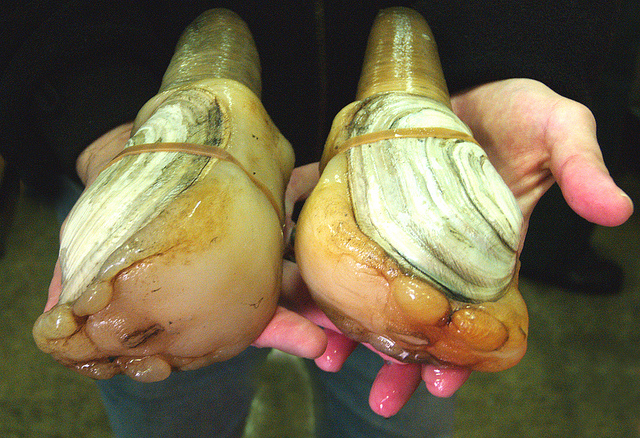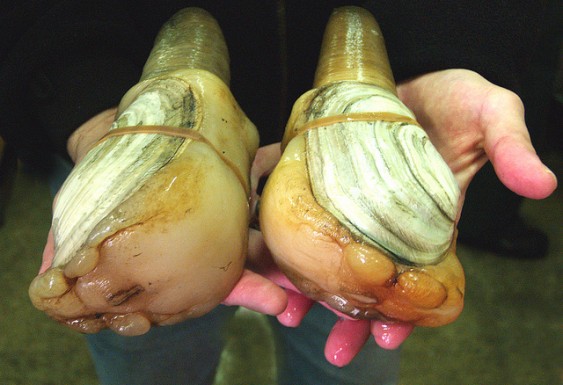Update: Outgoing governor Chris Gregoire this morning announced a $3.3 million budget recommendation and signed an executive order to begin funding ocean acidification research and other initiatives outlined in her blue ribbon panel’s report. The money would create an ocean acidification research center at the University of Washington, help shellfish hatcheries forecast when lethal water is headed their way, and allow the state to begin teasing apart how much of the problem is caused by global carbon emissions and local pollution that could be regulated. Gregoire’s proposal would reallocate funds from existing taxes on hazardous substances and revenue from leasing state shellfish beds, and would require legislative approval next year.
Here’s a quick rundown of recommendations made this week by Washington’s blue ribbon panel on ocean acidification, a phenomenon driven by carbon dioxide pollution that is making the oceans more corrosive and acidic. That’s a problem for creatures that need calcium carbonate to build shells and skeletons.
In Puget Sound, for instance, more than a third of all marine creatures—including oysters, scallops, clams, barnacles, geoduck, sea stars, abalone, and plankton—fall into that category. And modelssuggest that in the next 40 years, more than half the marine waters in our region will be corrosive to oyster larvae and other calcifying species.
The panel’s recommendations fall under several broad categories: (For more background on the problem and what’s driving it, see Sightline’s primer and blog series.)
- Do what we can to reduce carbon dioxide emissions that are causing oceans to become more acidic (Top of the list? Putting a price on carbon through a carbon tax shift or cap-and-trade system)
- Reduce nutrient pollution from septic systems, farms, and urban runoff that contributes to the problem
- Help the Northwest’s shellfish farmers on the front lines of the problem adapt to changing water chemistry
- Invest in critical research and monitoring
- Bring the public up to speed on an issue that few people recognize as a major threat to our oceans and economy
The report has 42 recommendations, 18 of which the panel has identified as “key early actions” that could be implemented quickly, such as paying for monitoring at shellfish hatcheries, identifying refuges for vulnerable organisms, and establishing pollution budgets to determine what the most important contributors are in different locations. All of the recommendations will cost money, and although the price tag would most certainly run into the millions, many have no identified source of funding. But the panel agreed that that should not be a deterrent to including them, says co-chair and former EPA administrator William Ruckelshaus:
We’re not ignorant that some of these solutions are going to cost money or there is going to be difficulty in implementing them. We’re not considering those things. We’re considering what ought to be done.
Of all the places on the planet, Washington and Oregon have been the first to see demonstrable harm from ocean acidification. Oyster hatcheries have suffered massive die-offs caused by corrosive seawater, and the universe of what we don’t know about how other species will react to changing water chemistry from rising carbon dioxide emissions is vast. That’s why Governor Christine Gregoire assembled a panel of scientists, policymakers, and industry experts to compile what we know about the problem, what we don’t know, and how we can begin to combat it.
So far, most local discussions have revolved around costs to Washington State’s shellfish industry, which is the nation’s largest provider of farmed oysters, clams, and mussels. But the potential damage to ocean systems from acidification goes much further. Scientists are beginning to document how elevated carbon dioxide levels affect whether a fish can smell predators or whether a mussel can stick to a rock. Just this week, Seattle scientists documented how corrosive seas causing the shells of pteropods, tiny snail-like creatures eaten by salmon, seabirds and whales in the Northwest, to dissolve at an unexpected pace.
Jane Lubchenco, administrator for the National Oceanographic and Atmospheric Administration who was in town to discuss the panel’s findings this week, called acidification “one of the planet’s most serious but widely underappreciated risks”:
This report really draws attention to a problem that exists internationally but that has really hit hard right here in the state of Washington…This is a jobs issue here, this is an economic issue here, and this is an environmental issue here, and that combination can provide additional rationale for making some headway with what is without a doubt a very, very challenging problem.
Here is more detail about some of the report’s key recommendations:
Carbon Emissions
While Washington State can’t control global carbon emissions, the state’s Climate Action Team and Energy Strategy have identified many steps to reduce local greenhouse gas emissions. Some have yet to be fully implemented, such as establishing low-carbon fuel standards, establishing insurance policies that charge drivers by the miles driven, investing more in low-income weatherization programs, and making polluters pay for the right to release carbon emissions. The state also needs more research to establish whether local sources of air emissions, such as tailpipe pollution from local driving, may be changing water chemistry.
Land-based Pollution
One of the most vexing problems the panel faced, according to Manning, is that scientists know that nitrogen and inorganic carbon pollution coming from sewage, erosion, and polluted runoff from farms, lawns, and urban streets can worsen ocean acidification. But they don’t have enough data to determine how much of the problem in a particular location is driven by carbon emissions versus local nutrient pollution. One of the most important recommendations is to collect data and establish methods to determine the relative contributions of these different pollution sources in any given location. Without that proof, it will be impossible to argue for more stringent regulations to curb that pollution.
Industry Adaptation
Several actions could be taken to increase the resiliency of natural systems and help the shellfish industry adapt, such as preserving native seagrasses that use carbon dioxide, conserve and develop species that are less vulnerable to acidification, use oyster shells to buffer pH levels in seawater, and expand monitoring networks beyond hatcheries to shellfish nurseries and farms.
Research and Monitoring
The needs for ocean acidification research and monitoring are vast and have been markedly underfunded on a national scale. Though the panel’s report does not put a price tag on all the research and monitoring needs, it calls for a significant investment in extended monitoring networks that serve as early warning systems, developing better indicators, building capacity to forecast corrosive waters, and lab and field studies to gauge how different species will fare in more acidic seas.
Public Education
In national surveys, only seven percent of Americans have heard of ocean acidification. Without a more widespread understanding of the rapid and unprecedented changes taking place in our waters—and the early actions that can be taken to begin to address them—it will be difficult to build support for those steps.
If Bill Dewey, a clam farmer and spokesman for Taylor Shellfish, could choose one point to get across to people, it might be this: Despite the economic toll it has suffered, Washington’s oyster industry is in some ways lucky. The worst damage happens in the first few days of a baby oyster’s life. If the hatcheries that grow them can avoid pulses of more acidic water during that vulnerable stage, or develop methods to treat it, then they have a decent chance of survival. But that won’t be the case in the natural world, Dewey reminds us:
We are truly the canaries in the coal mine, and we’re fortunate that oysters are most vulnerable. All the critters out there on their own in the ocean, they don’t have that luxury, they don’t have a safe harbor to go to. And that’s why it’s such an important message to get across that adaptation…is a short-term solution for a few species. In the… open ocean, this is a huge problem, and it’s going to change dramatically and in our lifetimes.













Southender
I don’t know why anyone would see this as anything but talk on their part. Gregoire and Manning have no history of real action on climate.
Manning, while at Ecology, failed to bring the statutorily mandated GHG reduction plan to the legislature (RCW 70.235.020 states: b) By December 1, 2008/, the department shall submit a greenhouse gas reduction plan for review and approval to the legislature, describing those actions necessary to achieve the emission reductions in (a) of this subsection by using existing statutory authority and any additional authority granted by the legislature. Actions taken using existing statutory authority may proceed prior to approval of the greenhouse gas reduction plan.
To date that plan has not been submitted. For the math challenged, tomorrow will mark the 4th anniversary of the deadline.
Also, while Manning was COS to Gregoire they allowed Ecology’s top climate staffer to submit a letter in the PSRC Transportation 2040 lawsuit saying that the state climate law wasn’t expected to apply to regional transportation planning organizations.
I could go on, but suffice it to say I wouldn’t put any stock in this being anything but more of the same. Let’s just hope Inslee doesn’t follow the same path.